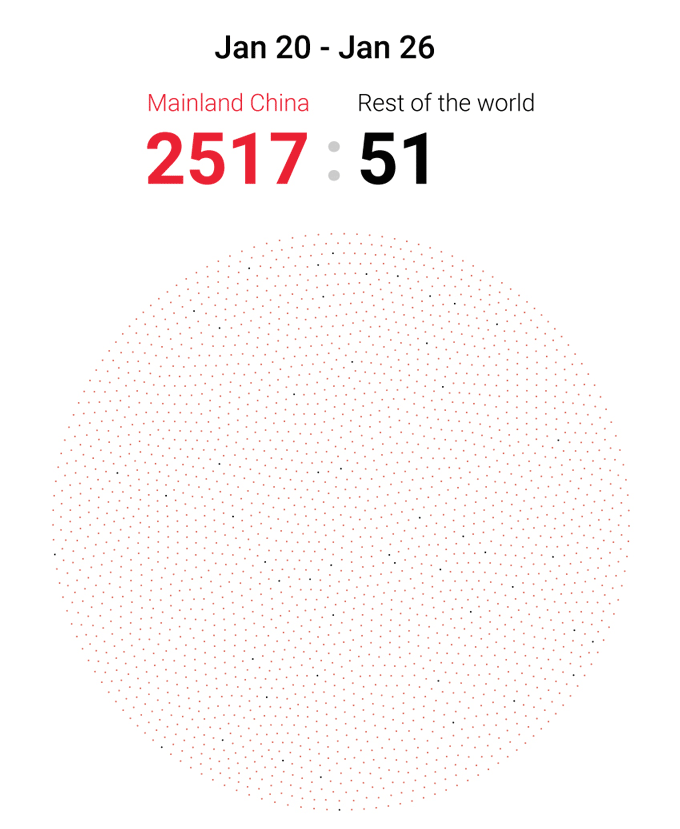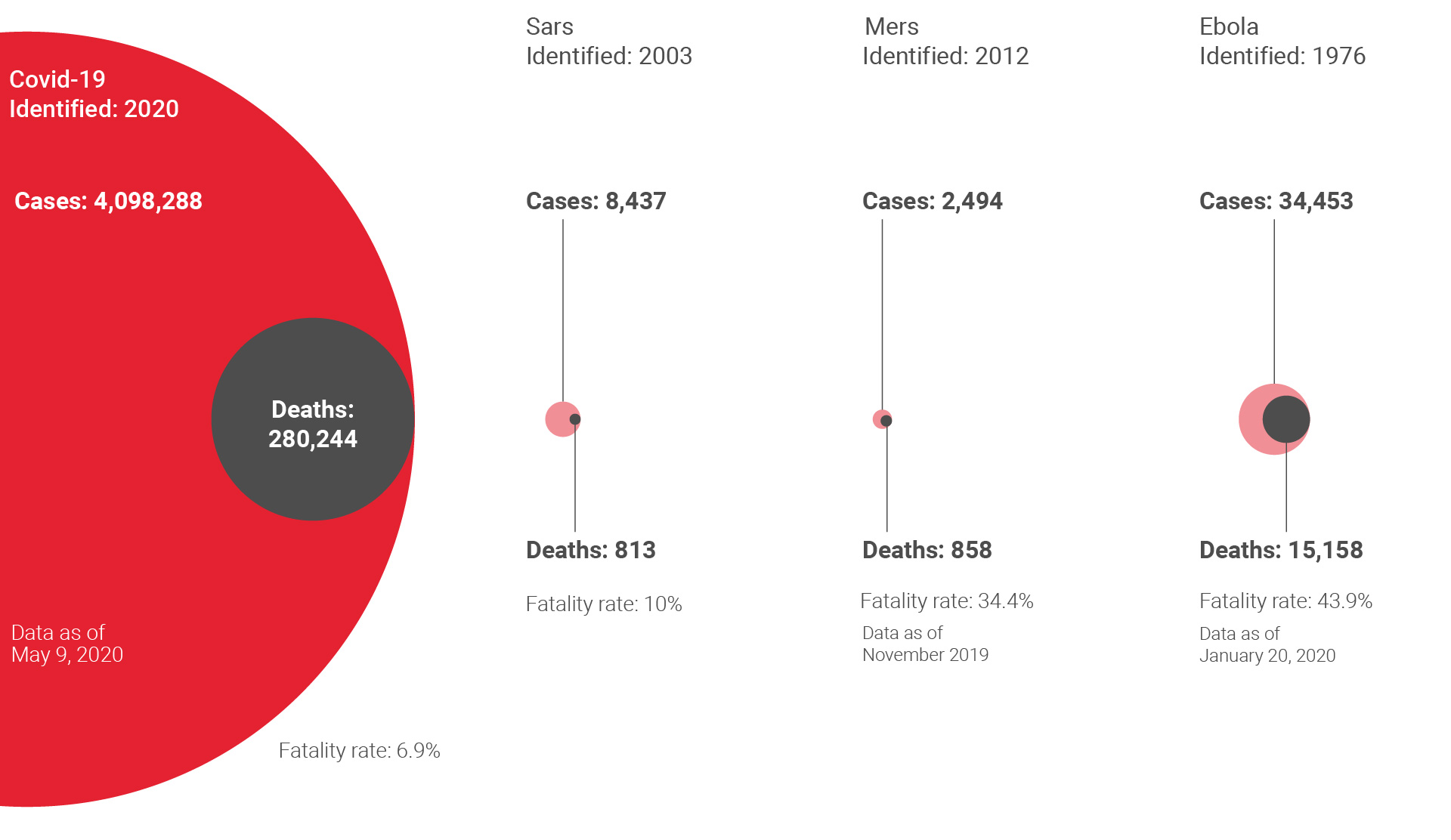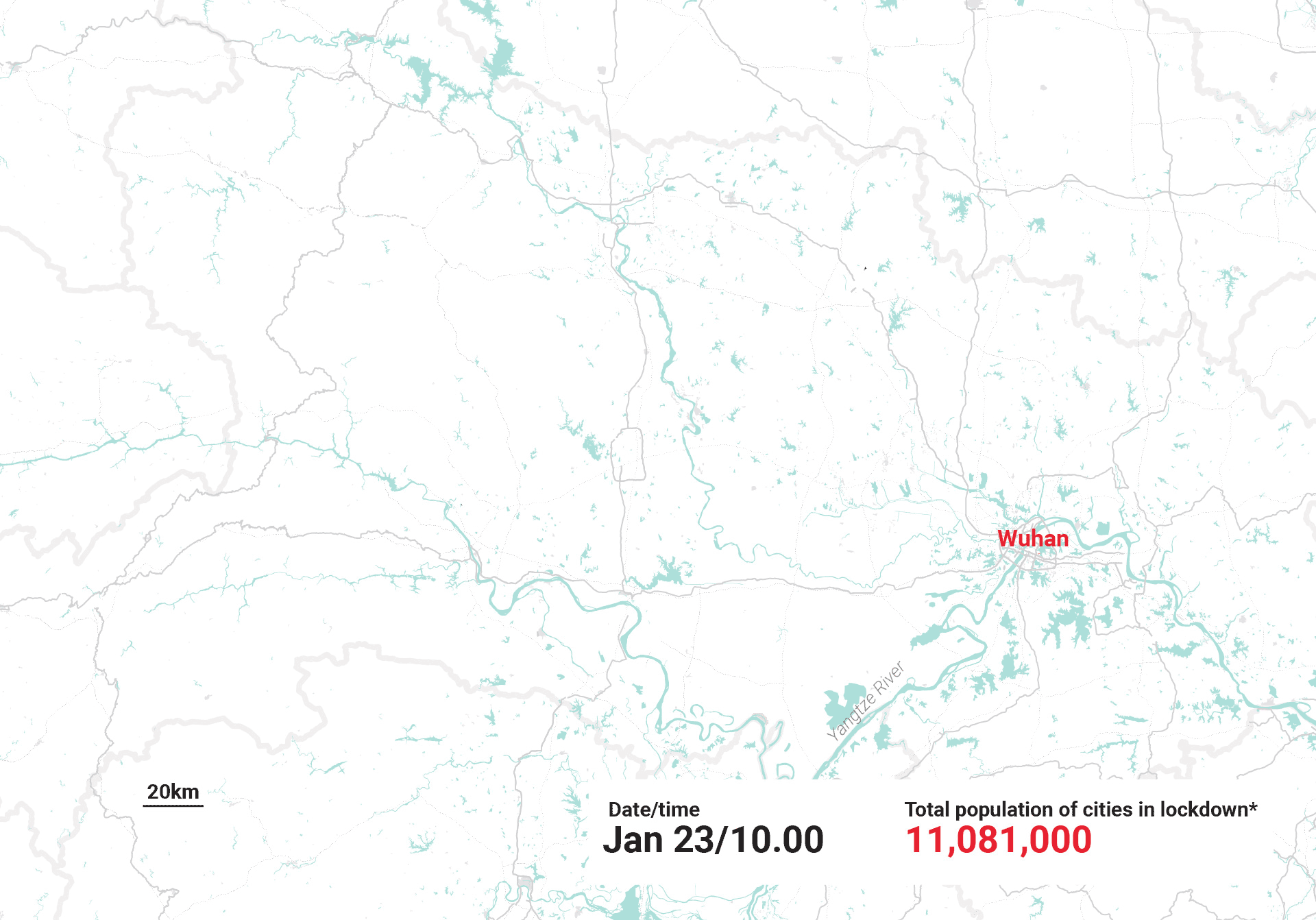South China Morning Post
Published January 21, 2020
See link for proper representation:
https://multimedia.scmp.com/infographics/news/china/article/3047038/wuhan-virus/index.html?src=article-launcher
Total cases75,752
Total deaths2,127
CountryCasesDeaths
Mainland China74,5762,118
Japan7101
South Korea1041
Singapore840
Hong Kong652
Thailand350
Taiwan241
Malaysia220
Germany160
Vietnam160
Australia150
United States150
France121
Macau100
United Arab Emirates90
United Kingdom90
Canada80
Philippines31
India30
Italy30
Iran22
Russia20
Spain20
Belgium10
Cambodia10
Egypt10
Finland10
Nepal10
Sri Lanka10
Sweden10
The then-mystery illness, Covid-19 was first reported in Wuhan last December, not long before the lead up to the Lunar New Year when China undertakes the world’s largest mass migration. Wuhan is the capital city of Hubei province and is a major travel hub connecting some of the nation’s biggest cities. With a population of 11 million, Wuhan city is larger than London or New York.
Global recovery cases
Hospital space in Wuhan
Wuhan Municipal Health Commission announced a surge of 15,152 new coronavirus cases, bringing the total number of confirmed cases to 32,994 after authorities changed their diagnostic criteria on February 12. The local government has converted a stadium, convention centres and schools into temporary hospitals to now have more than 40 designated clinics for critically or seriously ill patients.
EXAMPLE OF A MAKESHIFT HOSPITAL
Getting medical treatment
The authorities now divide patients into four categories to make the best use of the city’s medical resources. Here is the triage process:
Ambulance shortage
The 120 emergency hotline was jammed when more than 15,700 calls were made the day after the January 23 citywide lockdown, a Wuhan Emergency Medical Centre worker told state broadcaster CCTV. The city had just 57 ambulances for its 11 million people, far fewer than the national minimum requirement.
Medical service in Wuhan
The city has 27 Grade A tertiary hospitals and some of the highest levels of health services in the country, despite having far fewer ambulances per person than Shanghai or Beijing. Grade A tertiary hospitals are top-tier facilities, with some of the best doctors and the most advanced equipment on the mainland.
Wuhan had 3.57 licensed (assistant) medical practitioners and 4.91 registered nurses per 1,000 residents in 2018, putting it above the national average. Here’s how Wuhan compares with other major Chinese cities:
Medical workers
With the death toll continuing to rise, 189 medical teams with 21,569 medical workers have been sent to Wuhan, and 16 other cities in Hubei province, as of February 14.
On February 14, the NHC said 1,716 medical workers had been infected with the coronavirus. Of those, 1,502 were from Hubei province, including 1,102 from Wuhan.
Evacuated from Wuhan
As the death toll climbs, more countries plan to or already have evacuated their citizens from Wuhan. Thousands have returned home and been quarantined for at least 14 days on arrival to avoid contagion.
From imported cases to local transmission
On January 13, Thailand reported the first case of the coronavirus outside China. Eighteen days later, the Thai authorities were the first to confirm human-to-human transmission.
Face mask mania
Some cities in the region are running out of masks. In Hong Kong, people have queued overnight and reportedly paid more than five times the regular price for supplies. While masks can be useful during the incubation period – infected people can spread the virus before experiencing any symptoms – commercially available surgical masks are not effective at preventing the transmission of the coronavirus.
Unlike N95 respirators, the disposable surgical masks most people use are not designed to block the very smallest particles from entering the nose and mouth. They do lower the risk of infection but it’s next to impossible to create a perfect fit.
The virus is usually transmitted through droplets during sneezing or coughing. The vast majority of the droplets are less than 100 microns (0.1mm) across. Surgical masks are designed to prevent large droplets passing from one person's mouth to another person or surface. N95 respirators protect the wearer from breathing in particles bigger than 0.3 microns in diameter. When fitted correctly the respirators filter 95 per cent of airborne particles.
The World Health Organisation (WHO) says that while wearing a mask can help to limit the spread of some respiratory diseases, it is not enough to stop all infections. The best precautions are simple: wash your hands frequently, try not to touch your face, avoid crowded places and try to stay a metre from other people.
HAND HYGIENE
The WHO also only advises using masks if you have respiratory symptoms such as coughing or sneezing, mild coronavirus-like symptoms or are caring for someone suspected of having a coronavirus infection. Other key points are:
China’s neighbours take action
At least 15 jurisdictions have restricted or barred entry to visitors from China and/or Hubei province, while more than 20 airlines are suspending or reducing flights to the country.
New cases day-by-day
On January 27, there were 1,771 new infections in mainland China – the first biggest one-day jump since the outbreak started in December. On the same day, Chinese Premier Li Keqiang arrived in Wuhan to visit patients and hospital staff.

Deaths day-by-day
Coronavirus vs Sars:
daily cases and mortality rate
Status of cases in mainland China
How deadly is coronavirus?
On Wednesday, January 29, health authorities confirmed the number of coronavirus cases in mainland China had surpassed the amount of people infected by Sars during the 2002-03 epidemic. By the time the global Sars outbreak was contained, the virus spread to over 8,000 people worldwide and killed almost 800.

Symptoms and complications
Some infected people do not show any symptoms, while for others the symptoms can be severe, even fatal.
Children under two years old and people aged over 65, or with weak immune systems are particularly susceptible to developing severe complications such as pneumonia.
Incubation period
Where did 5 million Wuhaners go?
About five million residents left Wuhan before the city went into lockdown, revealed mayor Zhou Xianwang on January 26. Most headed to other cities in Hubei province according to Baidu, China’s popular search engine. Here we look at the top 30 destinations on two significant dates.
Flight Master, a popular Chinese travel platform providing ticket booking and data services, announced that three of the top 10 international destinations from Wuhan between December 30, 2019 and January 22, 2020 were airports in Thailand. As of January 30, Thailand has confirmed 14 cases of coronavirus, the highest figure outside China.
Where Coronavirus originated in Wuhan
The outbreak has been linked to Wuhan’s Huanan Wholesale Seafood Market, which has since been closed. Weeks after the market in the city in central China became ‘ground zero’, the authorities said human-to-human transmission played a role in the outbreak.
Animal meat that can carry the virus
Coronavirus represents a wide variety of viruses present in animals that can in certain circumstances jump to humans. Contact with meat from various animals sold in Huanan Wholesale Seafood Market has been established as the likely cause of the first reported human infections.
MEAT ADVERTISED IN WHOLESALE MARKET
Types of animal meat said to be available circulating online in China
STREET VENDOR PREPARES A FROG FOR
SALE IN A WUHAN STREET MARKET
SALE IN A WUHAN STREET MARKET
Wuhan as an International and domestic hub
Wuhan is an important transport link between the four cardinal points of China. Wuhan is a few hours by train to most of China’s important cities, which makes it a major hub in China’s high-speed passenger train network. The city has one of China’s top 10 economies and is a gateway to nine provinces. This has given rise to concerns that the disease could spread rapidly during the traditional mass migration of people over the Lunar New Year holidays.
Mainland Chinese cities in lockdown

How big is China's lockdown?
National populations compared to the number of citizens affected by the lockdown of cities in China

Wuhan waterways
Wuhan is one of the largest intermediate ports along China’s Yangtze River with ships connecting the city to Shanghai and Chongqing. At 6,397km the Yangtze is Asia’s longest river and the third longest in the world. It is used to ship food, products and for public transport.
Chinese authorities'
reaction compared to Sars

South China Morning Post special feature by:
Adolfo Arranz, adolfo.arranz@scmp.com
Pablo Robles, pablo.robles@scmp.com
Marcelo Duhalde, marcelo.duhalde@scmp.com
Han Huang, han.huang@scmp.com
Darren Long, darren.long@scmp.com
Adolfo Arranz, adolfo.arranz@scmp.com
Pablo Robles, pablo.robles@scmp.com
Marcelo Duhalde, marcelo.duhalde@scmp.com
Han Huang, han.huang@scmp.com
Darren Long, darren.long@scmp.com
Photo by Simon Song
Additional web development by Yaser Ibrahim
Sources:
OpenStreetMap, State media, Maps4News, National Health Commission of the PRC; Local Municipal Health Commission; China Health Statistics Yearbook 2018; US' Centres for Disease Control and Prevention (CDC),The Lancet, US Food and Drug Administration (FDA), WHO Summary of probable Sars cases and China's National Health Commission; Baidu Qianxi; BNO News; Flight Master
OpenStreetMap, State media, Maps4News, National Health Commission of the PRC; Local Municipal Health Commission; China Health Statistics Yearbook 2018; US' Centres for Disease Control and Prevention (CDC),The Lancet, US Food and Drug Administration (FDA), WHO Summary of probable Sars cases and China's National Health Commission; Baidu Qianxi; BNO News; Flight Master
South China Morning Post
Published January 21, 2020
Published January 21, 2020
https://multimedia.scmp.com/infographics/news/china/article/3047038/wuhan-virus/index.html?src=article-launcher